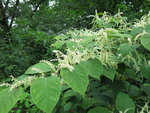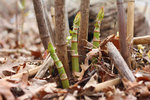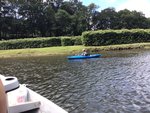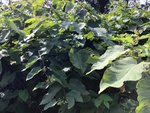Japanese Knotweed is pervasive and pernicious in the Upper Delaware River Watershed. At this time of year, when it is in bloom, it seems to be everywhere along the river plain, and along many …
Stay informed about your community and support local independent journalism.
Subscribe to The River Reporter today. click here
This item is available in full to subscribers.
Please log in to continue |





Japanese Knotweed is pervasive and pernicious in the Upper Delaware River Watershed. At this time of year, when it is in bloom, it seems to be everywhere along the river plain, and along many tributaries and roadsides as well, where it was not apparent only 10 or so years ago.
Knotweed rapidly colonizes riparian areas through rhizome and root growth, seed production and fragments of rhizome distributed in high water events. Where knotweed establishes it shades out all other native riparian vegetation. Though it is preferred nesting habitat for redwing blackbirds, provides shelter for mammals, and is a source of nectar and pollen for pollinators for the two weeks it is in bloom, native riparian vegetation provides a much broader range of habitat, shelter, nectar and pollen throughout the growing season.
In 2019 Friends of the Upper Delaware River (FUDR) was awarded a Delaware Watershed Conservation Fund grant to study the extent and impacts of knotweed and help landowners establish feasible objectives to manage it.
“We’re excited about this project because it will enable watershed stakeholders to gain a better understanding of the negative impact of knotweed on our river system and explore different management practices to assist property owners and natural resource professionals in their efforts to control this undesirable invasive plant,” said Jeff Skelding, FUDR executive director,
The research aims to document the distribution of the three species of knotweed to tailor management recommendations. It also is documenting the percentage of the 100 year flood plain of the Main Stem of the Delaware and the West and East Branches currently colonized by knotweed. Through aerial visible and infrared light photography converted into digital maps by Shippensburg University we will be able to model the impact of knotweed on the aquatic habitat, water quality and erosion. Stroud Water Resources will take the map data and through soil sampling and analysis and soil elevation data they will be able to determine whether our hypothesis is correct: while knotweed holds gravel, cobble and rock in place it does not hold soils and sediments which can wash into the river, eroding river banks, degrading water quality and aquatic habitat.
The project also includes demonstration sites and outreach to riparian landowners to provide information and hands-on knowledge of how they can set feasible objectives regarding knotweed on their property. Many people choose to do nothing because it is extremely difficult and expensive to eradicate. However, there are other management objectives landowners can adopt such as controlling its spread, fostering competition and succession from native vegetation, and attacking small isolated stands.
In 2021 we will establish demonstration sites at Deposit Village Park and Skinners Falls landing where existing stands of knotweed will be divided up into plots and different management techniques will be showcased. We will demonstrate controlling knotweed through repeated mechanical cutting, two forms of herbicide application, covering with an impermeable textile membrane and foraging by goats. A control plot will demonstrate the difference with the managed plots. Interpretive signage will explain each method and will link back to a website and social media for further information. Several onsite workshops are planned at these sites plus a site at Hancock Firemen’s Field.
Check back at www.fudr.org/knotweed for more information next year.
Knotweed is taking over the banks and the landscape of the Upper Delaware. It is along roadsides, streamsides and has taken over the islands in the river.
It is a very aggressive invasive species that:
Through five experimental plots, the FUDR Knotweed initiative will be testing and demonstrating different methods of control and removal. The initiative is hoping to inspire for landowners with knotweed on their property to set management goals, even when eradication seems impossible. In the photo, right, landowners have trimmed a box hedge. Others have created picnic and play areas and mazes among the dense vegetation.
Five methods of controlling
knotweed will be demonstrated:
ID and Treatment
Identifying the three species of Knotweed:
www.japaneseknotweed.co.uk/japanese-knotweed-identification
NY iMapInvasives, FUDR Knotweed Project
Add your identification of knotweed on your property to this map.
Knotweed recipes
Marie Viljoen’s knotweed recipes: www.gardenista.com/posts/weeds-you-can-eat-japanese-knotweed-hummus/
Bon Appetit: www.bonappetit.com/test-kitchen/ingredients/article/japanese-knotweed-recipes
Leda Meredith: www.ledameredith.com/japanese-knotweed-bars-wild-food-recipe/
Make Mason Bee houses with knotweed stalks
Jeff Skelding, executive director
Sherri Resti Thomas, deputy director
Molly Oliver, policy director
Steven Schwartz, knotweed project consultant
Jessica Welles Newbern, biologist, National Parks Service, Upper Delaware S&RR
Dr. Eric Burkhart, biologist
Emily Weaver, biologist
Alfonso Yanez Morillo, geographer, Shippensburg University Center for Land Use and Sustainability (CLUS)
Antonia Price, geographer, SU (CLUS)
Dr. Claire Jantz, geographer, SU (CLUS)
Dr. Melinda D. Daniels, associate research scientist, Stroud Water Research Center
Tom Lewis, Trillium Invasives Management
Jonathan Milne and Audrey Ek-Psomas, LightHawk
Comments
No comments on this item Please log in to comment by clicking here